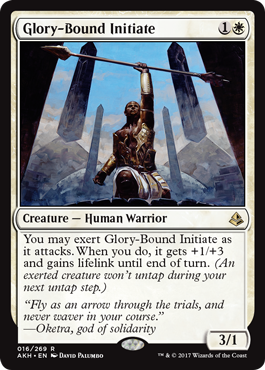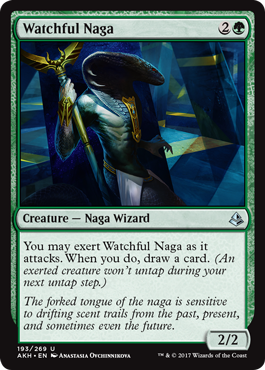Greetings and Exertations
Amonkhet is all about pushing yourself to the limits.
The people of Amonkhet strive to complete the five Trials, and they will do so no matter what it takes. If they're winded after a fight or need a moment to recover from a harrowing Trial, they can take it—and know that they came out of that ordeal in better shape than the others.
And in games? That kind of mentality manifests in the exert mechanic, making its triumphant debut in Amonkhet.
And why hold back on that sweet preview card? Let's take a look at a rare with exert and talk about how you might use it.
Let me introduce you to Glory-Bound Initiate:

In addition to being bound for glory, this Initiate is also bound to be seen attacking your opponent in Standard tournaments over and over again.
Let's break it down.
For two mana, you get a 3/1. That's not quite good enough on its own to make most aggressive Constructed decks—but it's not far off, either. Hitting for 3 with your two-mana card is no joke and can quickly whittle down your life total.
And then there's that exert ability.
Exert rewards thinking ahead and figuring out if you should be exerting this turn or not. Some of the exert rewards are incredibly powerful—when activated appropriately.
Exerting your creature is no small cost: you essentially lose access to it for a turn. If you exert a Glory-Bound Bound Initiate and it wasn't going to be blocked either time, you've just given up 2 points of damage. So, it had best be worth it.
When are some times when exerting makes the most sense? Well . . .
1. When your creature couldn't get through otherwise
Some creatures quickly get outclassed or are subject to unfavorable trades. Exert can help them get through and hit your opponent long after they would normally be able to.
Take Glory-Bound Initiate as an example. A big weakness of a 3/1 is that they die to almost any blocker. Any random 1/1 Servo or Insect token lying around will happily jump in front of your 3/1 creature.
Well, Glory-Bound Initiate has seen to that problem.
It can crash in for 3 damage on its own—and if blockers pose a threat, it can take a turn off to attack as a 4/4 with lifelink! That helps make sure it's still a functional attacker as the board develops. (Plus, the lifelink helps give you a safety cushion while the Initiate isn't available to block.)
A lot of exert effects grant creatures state bonuses or a form of evasion, and using those to get through when you'd otherwise be unable is something you can expect to do with regularity.
2. When you need the effect
Of course, not all exert effects are about getting your creatures past blockers. Some of them are potent abilities that are unrelated to combat. And in these cases, you have to decide which is more important: being able to attack (or block!) next turn or the effect.
What's a card that is an example of this? Take a look at your preview card, Watchful Naga!

The question here: is the 2 damage you would give up next turn worth the card?
As I mentioned earlier, with exert it is important to plan ahead. What do you think are the odds your opponent will have a creature that can block the Naga next turn? If it's high, you should probably exert this turn anyway—the Naga likely wouldn't be able to attack next time.
And, of course, if you think there's a chance your creature will die in combat, make sure to get that exert effect!
Attacking your Watchful Naga into your opponent's 2/2 should prompt you to exert it ahead of time. That way, you're up a card even if your opponent trades. And if they don't, perfect: that Naga will give you another card a little ways down the line.
3. When your deck has exert synergy
There are a few kinds of cards that work extremely well with exert.
A major example of this is anything that untaps or grants vigilance. For example, try combining exert with Shadows over Innistrad's Always Watching.
Exert keeps your creatures tapped . . . but if they don't tap to attack in the first place, that's no downside at all!
With Always Watching, you can exert turn after turn. Suddenly, Glory-Bound Initiate from earlier is attacking as a two-mana 5/5 lifelink vigilance every turn. Pow!
And in addition to finding combos with existing Magic mechanics, there are also some cards that even call out exert by name. Check out Battlefield Scavenger!

On its own, this card is plenty reasonable as a 2/2 that lets you "rummage" away a card when it attacks. But in a deck with several other exert cards, it can really help you cycle through to find what you need.
Potentially giving up 2 damage with the Glory-Bound Initiate could make a lot of sense if you also got a free rummage out of the deal. You can definitely build an exert deck that takes advantage of all these kinds of cards.
Overexerted
Exert is a surprisingly deep and interesting mechanic to play with. If you use it properly, you'll find it carrying you to victory plenty often—just like the warriors of Amonkhet.
My largest piece of advice with exert is to think ahead. If you can start to figure out what the creature landscape will look like next turn, you can make some well-informed decisions about whether you want to exert.
And then, of course, sometimes exerting will just kill your opponent. If there isn't another untap step, exerting isn't such a big deal.
Hopefully you enjoyed this look at exert, one of Amonkhet's new mechanics! There's plenty to build with here, so try putting your exert cards together and seeing what happens.
If you have any thoughts or questions, I'd love to hear from you. I can be reached on Twitter, Tumblr, or via email in English at BeyondBasicsMagic@gmail.com.
I'll be back next week with another slice of Amonkhet previews. Enjoy all the other great preview cards up, and I'll talk with you again soon!

